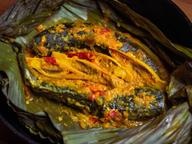Dish
Chicken in soy sauce (Ayam kicap)
A perfectly delicious chicken dish for those days when you really don’t have the energy to cook.
Beef peratal
This tender, aromatic semi-gravy dish is an excellent centrepiece for beef-eating Tamils during Tamil New Year and Ponggal.
Sambal tempoyak daun kayu
Thinly sliced daun kayu or cassava shoots cooked in tempoyak is a classic Negeri Sembilan dish.
Tempoyak ikan patin
Fermented durian gives this classic Pahang dish a rich taste and heady aroma.
Taucu fish
Salty and aromatic pantry ingredients marry in this savoury foil for plain starch.
Kari kaja’ siyok (chicken feet curry)
A Dayak chicken curry made with an often-overlooked off-cut: chicken feet.
Chicken pineapple curry
We’ve been putting fruits in savoury dishes for ages in this part of the world, such as this chicken curry which gets a tangy boost from pineapple.
Huan chu heok masak lemak
A Nyonya classic that uses sweet potato and its leaves in one luxurious dish.
Chai poh tofu
Cold smooth tofu topped with crunchy aromatics makes for a quick lunch when you don’t want to turn on the stove.
Singgang
Make this singgang with extra soup to sip on slowly when you’re under the weather.
Mochai karuvadu kuzhambu (Field beans & salted fish curry)
A deeply savoury curry found in many South Indian and Ceylonese homes.
Canned stewed pork with potatoes
A humble stew of meltingly tender meat using an underrated star of home cooking—canned stewed pork.
Indian-spiced tofu
Give tofu some extra love with a healthy dose of warm spices and plenty of complementary textures.
Coriander prata
How much coriander can you pack into one roti? Quite a bit, as it turns out.
Pinarasakan sada bambangan (Braised fish with wild mango)
When bambangan season rolls around, this braised fish is a delicious way to use up a glut of the fruit’s harvest.
Kurat kasam dihan (Splitgill mushrooms with tempoyak)
There isn’t much that tempoyak can’t improve, and cooking it with mushrooms both complement and enhance the overall umami of both ingredients.
‘Bitter’ porridge
This minimalist Lunbawang staple manages to be satiating and incredibly comforting without being heavy.
Yau mak with onion-garlic oil
The onion-garlic oil provides a lightning-fast way to get flavourful vegetables on the table for dinner.
Steamed fish with onion-garlic oil
Low-stakes steamed fish to get you accustomed to making this favourite at home.
Chicken with semomok & kulim
A Semai-style chicken braise full of flavour, suitable for your daily cooking repertoire.
Sambal goreng
While sambal goreng can easily feed a crowd during Raya festivities, it can also be made all year round as a clean-out-the-fridge treat.
Cashew chicken kurma
A mild, gently spiced curry thickened with cashews and fresh coconut.
Ketchup pork
Sometimes, all you need is some meat and ketchup. This slightly zhuzhed-up bachelor-esque dish is great for a quick meal.
Bok choy in coconut milk
If you’re tired of stir-frying, blanching or steaming bok choy, try braising it instead in coconut milk.
Braised fish head with fuchuk
Using just a few pantry ingredients—aside from the fish head, of course—this speedy dish is quite simply what it says in its title.
Kacangma chicken
Strong in flavour, this dish stands out in the CNY feast lineup. Perfect served with sweet vegetables and hot white rice.
Green beans poriyal
A quick vegetable stir-fry with the classic savoury spices of an Indian kitchen.
Mutton varuval
A deep, dark, complex mutton dish to impress your guests on festive occasions.
Stir-fried kangkung with budu
A spicy and savoury vegetable side for the dinner table, with budu as the star.
Spicy egg sambal
An any-meal sambal-scramble that can be stored in the fridge for busy days.
Orh oh bak (Yam and pork in soy sauce)
A Hakka homestyle dish that became an instant classic in Zara’s home.
Hu chee rumpah (Sambal-stuffed fried fish)
Sambal-stuffed fish is a highlight at many nasi campur stalls; you can now make it at home.
Char swee (Stir-fried cucumber in vinegar)
Cooking cucumbers isn’t a novel method. This excellent Nyonya recipe shows us a tangy application for weeknight meals.
Winged bean kerabu
Make this simple vegetable side dish without even turning on the stove.
Malay wedding-style beef liver
All you’ll need for a kenduri at home are a glass of F&N rose syrup, nasi minyak, and a hearty helping of this dish.
Mrs Menon’s mango curry
A sweet introduction to the world of fruit curries, this mango curry is perfect for an Onam Sadhya lunch.
Luncheon meat masala
Turn a can of luncheon meat into a spicy dish, a perfect pantry meal to cook before grocery runs.
Braised turmeric chicken
When you want ayam kunyit but can’t bear the oily cleanup, turn to this braise instead.
Sardine sambal
Wonder why sardine sambal isn’t up your alley? Try this pre-frying technique and let us change your mind.
Linugu tanggalung kinayan limau om bawing (Roasted eggplant with lemon basil salad)
A smoky eggplant salad to accompany a variety of meals, from rice to steaks, or as a part of an appetiser platter.
Bosou sada
Ferment your fishing trip catch with this method, and enjoy a uniquely Kadazandusun flavour while you’re at it.
Pinongian sada
For those familiar with fermenting their own fish, try this Kadazandusun twist and add pangi or keluak to the mix.
Stir-fried cabbage with almond flakes
Swap out the usual stir-fry aromatics for fragrant and crunchy almond flakes instead.
Yellow chicken gulai
Chicken and coconut milk come together in a simple preparation of gulai kuning or masak lemak, perfect for a quick yet satisfying meal.
Aloo mutton keema
A versatile minced meat sauce that can be paired with your carb of choice for a complete meal or even a quick snack.
Yam chicken
The kind of homestyle weeknight braise you probably won’t find in a restaurant.
Terung Dayak with mackerel
This dish is a common staple on Diana’s family dining table, as her mom would buy terung Dayak whenever they were in season.
Banana heart kerabu
Rather than raw, this kerabu includes cooked elements that result in something like a masak lemak.
Sweet mango chutney
Unlike many other chutneys popular in the Malaysian-Indian repertoire, this one veers sweet and makes for a great snack on its own.
Fried rendang
Soft and tender chunks of meat without hours on the stove is not possible, but getting those spicy rendang flavours definitely is.
Creamy spicy chicken curry
This version of Malaysian-Indian chicken curry uses store-bought curry powder such as Baba’s, but is taken up a notch with extra spices.
Acar hu
This Nyonya-style fish pickle ticks all the tasty flavour boxes: tangy, fatty, savoury, sweet.
Tau eu bah
Grandma Ong incorporates spices not found in the original recipe, bringing a Nyonya punch to this crowd favourite.
Pumpkin masala
A subtly spiced and hearty side dish, unfussy enough for a weeknight.
Umbut sawit in belacan
Umbut sawit is the young shoot or heart of the oil palm tree. Plentiful in Borneo from the plantations, resourceful locals have found that it makes for a terrific ingredient.
Paeh ikan keli
The Temuan way to cook this fish is over the embers of an outdoor stove. We highly encourage you to go for it if you have a grill.
Ayam asam rong
This is a traditional recipe originating from Jerantut, Pahang, and has since spread to neighbouring areas in the state.
Gaeng som
This dish, inherited from Banyen’s late grandmother, makes an appearance at least twice a week on their dinner table at home.
Shukto
Leela’s late mother was the family’s ‘culinary comforter’, and taught her how to make this vegetable dish. Complex in flavour, this recipe takes no shortcuts.
Eurasian braised tongue
This recipe is adapted from Indonesian semur, which itself is an influence on smore, a common Eurasian dish in Malaysia and Singapore.
Pekasam ikan
Many kampung folks catch freshwater fish as a cheap source of protein, and pekasam is a way of fermenting a glut of a catch.
Granny’s chicken pongteh
The slow braise of ingredients in this pong teh coax out every bit of flavour—it’s worth splurging on good chicken and soy sauces.
Shallot prawns
Between the char of the crispy shallots, the umami of the soy sauce, and the sweetness of the prawns, one really doesn’t need anything else.
Kangkung belacan
This is quite possibly the best version of kangkung belacan we’ve tried—spicy, briny and still-crunchy.
Hinava tenggiri
Hinava is a traditional native dish of the Kadazandusun people in the state of Sabah, which is a method of cooking saltwater or freshwater fish using lime juice.
Fenugreek fish sambal
The star of this dish is fenugreek, along with the freshest fish possible.
Chicken lihing soup
Natasha learned how to make this dish from her mother (who she assumes learned it from her mother), and craves it on gloomy rainy days.




































































